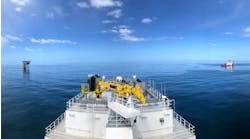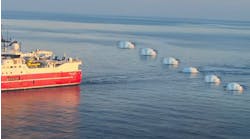Niels Dijksman, Andrew Evans, Dominic McCormick, Jan Stammeijer - Shell
Throughout Schiehallion’s field life, 4D seismic has been a key reservoir surveillance tool. Recent advances in data quality, analysis, and calibration with reservoir data have enabled 4D to offer even more quantitative insight into voidage and waterflood management. When used in support of the field’s infill drilling program, these 4D advances are helping Shell and BP attain the goal of 40% recovery.
As the following case history shows, however, Shell and BP have discovered that 4D can be effective as a reservoir management tool only when calibrated using continuing data acquisition from the wells.
Qualitatively, in seismic 4D terms, Schiehallion waterflood management is a process of “turning out the lights.” On monitor surveys, water sweep from injection wells to production wells progressively dims the high amplitude direct hydrocarbon indicator (DHI) that detailed the oil accumulation on the baseline data.
Sometimes the opposite has occurred, however. Areas of seismic amplitude brightening around producers were prominent in early 4D surveys and were a response to gas breakout due to lack of pressure support. This is much less widespread now because of improved placement of in-channel injectors, which brought field voidage back on track. Prominent amplitude brightening has occurred also around one injector, indicating pressuring up of an isolated reservoir compartment.
The 2004 4D survey was used to support continued infill drilling to help manage the waterflood, with the first infill production well, WP14, drilled in 2005.
Drilled from the West drill center, it aimed at the 30-m (98-ft) thick T31 Upper (T31U) reservoir. The target was an attic location in Segment 1 up-dip from existing development well WP02. Here the T31U has sheet-like rather than channelized geometry, as is the case further east in Segment 1, and consequently was modeled as well connected.
WP14 is in an area that showed 4D amplitude brightening consistent with gas breakout due to poor pressure support in early field life. This became less pronounced by 2004, suggesting water injection at that point was more effective. In 2005, however, data acquired from an appraisal well and from a PLT in WP02 indicated that the T31U reservoir was significantly depleted. Another factor, fluid compositional change, had come into play to complicate the 4D analysis.
In response, the operator fasttracked an additional T31U injector. Here, 4D is key to understanding where the flow barriers are between the wells and has played an important role in placing the well.
Drilling, PLT results
Vertical appraisal well W11, drilled in Segment 1 around 300 m (984 ft) from well WP02 to confirm the hydrocarbon contacts in the deep T28 reservoir, also provided the opportunity to sample the shallower T31U and T31L pressures. The T31U unexpectedly was depleted by 500 psi (3.25 MPa) whereas T31L was closer to virgin pressure.
Further information came from a PLT in well WP02, confirming lack of oil production from the T31U reservoir due to poor injector support from WW06.
Finally, attic producer WP14 was drilled and completed over the T31U sand in Oct. 2005. As anticipated, the reservoir section drilled was significantly pressure depleted by 700-800 psi (4.8-5.5 MPa), with “fizzy oil” and gas present in some sections
4D at WP14
The WP14 result was not consistent with initial predictions from 4D. The brightness of the WP14 target location on the 2002 4D data indicated poor pressure support and risk of a secondary gas cap that would impact the value of the well. By 2004, amplitudes had reduced, suggesting gas has re-saturated into the oil, and pressures were back close to bubble point.
However, the 2005 W11 pressure (MDT), WP02 PLT surveys, and WP14 result proved the area is depleted to far below the initial bubble point (2,680 psi or 18.5 MPa @ datum). Remarkably, no significant gas was logged in the wells. This lack of gas at such low pressures only occurs if the composition of the crude has changed because of production. This compositional change can be explained easily by the fact that WP02 has produced at a gas-to-oil ratio (GOR) higher than the solution GOR (GORp > GORs), thereby extracting significant amounts of gas from the crude. The saturations in the WP14 log - and specially the “fizzy oil” interpretation - allow accurate estimation of the current bubble point pressure and put it at 2,190 psi (15 MPa), which is 490 psi (3.4 MPa) lower than the initial bubble point
The 4D seismic is insensitive to the direct effects of pressure depletion. On the other hand, gas break-out is easily recognized. It can be used as a secondary pressure indicator but becomes unreliable if production GOR is greater than solution GOR because of possible changes in the bubble point of the crude.
Additional injector
The weight of evidence now pointed to an urgent need to supply pressure support to the T31U reservoir. The drilling program proved flexible enough for BP, after review with Shell and the other partners, to schedule an additional T31U injector well for early 2006.
Target selection for the new injector was influenced strongly by the 2004 4D data. Comparison of 4D baseline and monitor seismic sections through WW06 showed a zone of amplitude dimming through time around the well, consistent with water sweep extending out into the reservoir. Surprisingly, the extent of sweep in the T31U was evidently small, given the well has been injecting since 1998. Most of the water (from a total 68 MMbbls by end Nov. 2005) apparently went into the T31L.
In contrast, further south there was amplitude brightening, indicating potential gas break-out as a consequence of pressure depletion due to unsupported production from WP02. When mapped, WW06 injection into T31U was shown to be restricted by an east-west trending linear boundary. This trend is typical of faulting in Schiehallion, but no fault had been recognized, for example, on seismic coherency data. This qualitative interpretation also was confirmed by the results from Bayesian inversion of seismic attributes.
Confirmation that the T31U reservoir was affected by a fault came from structural interpretation at deeper levels. When extended upward and westward, a mid-segment fault mapped at T28 level proved coincident with the flow barrier identified from 4D.
The new injector was placed immediately south of the east-west mid segment fault that restricted sweep from WW06. Better reservoir development and a reduced risk on connectivity to the south favored placing the well further east than WW06. This location provided the best opportunity, based on current data, for effective sweep of the T31U reservoir towards wells WP02 and WP14. The well was drilled and completed in March 2006 and encountered 600 psi (4.14 MPa) depleted T31U reservoir of slightly better quality than expected. Injection rates of 25,000 b/d of water have been achieved.
Lesson learned
Integration with other reservoir surveillance data is often stated as a guiding principle in using 4D. At Schiehallion, Shell has found the use of well production data to be important in understanding the 4D seismic response in terms of not only pressure and saturation changes in the reservoir, but also production-related changes in the bubble point of the oil. Barriers to flow emerged that were not initially mapped at reservoir level but can be related to the structural make-up at deeper levels. The 4D seismic program at Schiehallion is thus providing valuable insight into the pattern of water sweep that Shell and BP need to guide their continuing in-fill drilling program.
Field at a glance
Schiehallion field was discovered in 1993 and came onstream in 1998. Shell and BP each have a 33.35% share, with BP operating the field. The development, in 350 m (1,148 ft) water depth, consists of subsea completed wells from three subsea drill centers tied back to an FPSO. A water injection scheme for pressure support has operated from start-up.
The oil is 22-26° API crude of about 3 cP viscosity with a bubble point close to the initial reservoir pressure of 2,900 psi (19.99 MPa). So far, 240 MMbbl of oil have been produced and rates are 65,000 b/d. Expected reserves are about 550 MMbbl, with a further 120 MMbbl scope for recovery.
The Schiehallion reservoir is at 1,800-2,064 m (5,905-6,772 ft) in a Palaeocene deep marine complex of four main channelized high-quality sandstone sequences (T25, T28, T31, and T34/35). East-west trending, southerly dipping faults that on a production time scale are mostly sealing, divide the field into four main segments.
On seismic, Schiehallion is defined by direct hydrocarbon indicators, and as a result, attribute-based net hydrocarbon sand predictions are used to map oil distribution rather than conventional structural interpretation. Net sand in the reservoir full-field model is “conditioned” using amplitude attributes from inversion products. Field appraisal was based around the first 3D seismic survey acquired in 1993. A second, higher specification field development survey followed in 1996.
Monitor surveys were shot 4D in 1999, 2000, 2002, and 2004. Mapped differences in seismic attributes over time have been used as a primary information source to track performance of producer-injector pairs (conformance). Using pressure data from permanent downhole gauges, and production and injection rate histories, the operator has optimized the injection and off-take strategy in under-performing pools. Pressures and saturations from infill drilling together with (sparse) production logging data complement the main suite of reservoir data used to guide further field development and production management.
The biannual program of 4D acquisition continued into 2006. In the longer term, permanent seabed cables may be deployed, removing the need for two-boat undershooting at the FPSO and facilitating more regular data acquisition, matching the likely requirement to examine reservoir changes on an ever finer scale.






